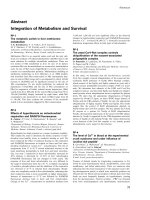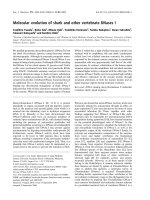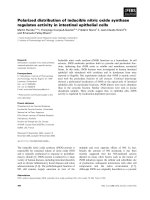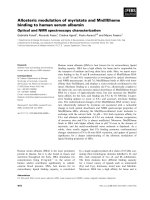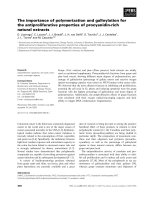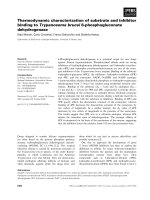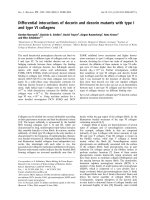báo cáo khoa học: " Clinico-pathological profile of head and neck malignancies at University College Hospital, Ibadan, Nigeria" pdf
Bạn đang xem bản rút gọn của tài liệu. Xem và tải ngay bản đầy đủ của tài liệu tại đây (970.58 KB, 9 trang )
RESEARCH Open Access
Clinico-pathological profile of head and neck
malignancies at University College Hospital,
Ibadan, Nigeria
Akinyele O Adisa
1*
, Bukola F Adeyemi
1
, Abideen O Oluwasola
2
, Bamidele Kolude
1
, Effiong EU Akang
2
and
Jonathan O Lawoyin
1
Abstract
Introduction: This retrospective study analysed head and neck malignancies seen over a 19-year period at the
University College Hospital, Ibadan.
Methodology: One thousand, one hundred and ninety two patients with head and neck malignancies were
analysed according to age, gender, topography and histology.
Results: There was an annual hospital frequency of 62 cases per year. The overall mean age for these malignancies
was 43.9 (SD ± 19.3) years. The lesions from the respiratory tract were the most frequent (43.2%) of all cases. The
palate was the most frequent intra-oral site (13.8%). Epithelial maligna ncies constituted 73.4% of all cases with a
male: female ratio of 2:1, a mean age of 48.1 (SD ± 17.5) years and were mostly located in the larynx (19.7%).
Lymphomas constituted 17.5% of all head and neck cancers with a male: female ra tio of 1.6:1, a mean age of 35.1
(SD ± 20.6) years and nodal involvement (39.7%) was most common. Sarcomas constituted 8.9% of all
malignancies with a male: female ratio of 1.5:1, mean age of 27.1 (SD ± 16.7) years and the maxillofacial bones
(42.5%) were most commonly involved. Neuroendocrine malignancies accounted for 0.2% of head and neck
malignancies with a male: female ratio of 1:1, a mean age of 28.5 (SD ± 6.4) years and both cases involved the
nose.
Conclusion: This study has further confirmed that carcinomas remain the most frequent cancers of the head and
neck region in south-wester n Nigeria.
Keywords: head and neck malignancies clinico-pathologic profile, south-western Nigeria
Introduction
Head and neck cancers are malig nant neoplasms occur-
ring in the nasal cavities, paranasal sinuses, nasophar-
ynx, hypopharnyx, oropharynx, ear, scalp, oral cavity
and salivary glands [1]. These malignancies are asso-
ciated with various aetiological factors such as tobacco
and alcohol u se [2], infection by oncogenic viruses,
genetic factors and nutritional deficiency [3].
Head and neck cancer is the tenth most common can-
cer in the world [4] and is an important cause of mor-
bidity and mortality [5]. Patients with head and neck
cancer have specific requirements that are beyond the
needs of most other patients diagnosed with other types
of cancer [6]. Several assorted histological types of
tumours are found in the head and neck region.
Between 70% to 90% of head and neck cancers are
epithelial in origin, and squamous cell carcinoma consti-
tutes 66.7% of carcinomas and 47.8% of all head and
neck cancers [7,8]. About 30% of all lymphomas occur
in this region and they comprise the second most com-
mon primary malignancy in the head and neck region
[9]. About 15% to 20% of all sarcomas are diagnosed in
the head and neck region [10]. Osteogenic sarcoma,
rhabdomyosarcoma, malignant fibrous histiocytoma and
angiosarcoma are the most common histological types
* Correspondence:
1
Departments of Oral Pathology University College Hospital, University of
Ibadan, Ibadan, Oyo state, Nigeria
Full list of author information is available at the end of the article
Adisa et al. Head & Face Medicine 2011, 7:9
/>HEAD & FACE MEDICINE
© 2011 Adisa et al; licensee BioMed Central Ltd. This is an Open Access article distributed under the term s of the Creative Co mmons
Attribution Lice nse ( which permits unrestricted use, distribution, and reproduction in
any medium, provided the original work is properly cited.
[11]. Saliv ary gland malignancies constitute about 1% of
all head and neck cancer [7].
The prospects of head and neck cancer depends on
histological t ype, degree of histological differ entiation of
the tumour cells, clinical staging, primary site of
tumour, age of patient, co-morbid conditions a nd
neuro-vascular inva sion [12]. The purpose of t his study
therefore is to estimate the importance of a clinic o-
pathologica l profile of head and ne ck malignancies in
western Nigeria.
Methodology
This is a retrospective study that provides analysis of
head and nec k malignancies (with respect to age, ge n-
der, topography and histologi cal diagnosis) at the Uni-
versity College Hospital (U.C.H.) Ibadan from January
1990 to December 2008. Local ethical clearance was
obtained fro m the Joint University of Ibadan/University
College Hospital Ethical Revi ew Committee (registration
number: NHREC/05/01/2008a).
Biopsy report registers were obtained from the depart-
ments of Oral Pathology and Pathology U.C.H Ibadan
and records of all malignant lesions involving the oral
and nasal cavities, the paranasal sinuses, oropharynx,
nasopharynx, hypopharynx, larynx, trachea, ear and sali-
vary glands [1] were included. Malignancies involving
the thyroid, eye and brain were excluded [1].
The age grouping system used is that recommended
for morbidity in health by the Department of Interna-
tional Economic and Social Affairs of the United
Nations [13]. 1-14 years (children), 15-24 years (young
adults or adolescents), 25-44 years (older adults), 45-64
years (middle aged), ≥65 years (elderly).
The data was entered into the version 16 of the Sta-
tistical Package for Soci al Sciences (SPSS16). Qualita-
tive data were expressed as percentages and compared
using chi-square statistics. Quantitative data were
summarised using mean, standard deviation and con-
fidence interval. The data were further compared
using student t-test and/or one-way analysis of var-
iance test as appropriate. The level of significance was
setatp<0.05
Results
The hospital based prevalence was about 62 cases of
malign ant head and neck neoplasms per year. The time
trend of relative frequencies during the period showed
no regular pattern. However, none of the years recorded
less than 40 patients (Figure 1).
Gender Distribution
A total of 781 (65.5%) males and 410 (34.4%) females
presented during the period under study [the gender of
1 person (0.1 %) was n ot indicated i n the record]. The
overall approximate male to female ratio for malignant
head and neck neoplasms was 1.9:1.
Age Distribution
The patients’ ages ranged from 1 year to 98 years with a
mean of 43.9 years (SD ± 19.3). There was no statisti-
cally significant difference between the mean ages of
males and females (t = 1.145, df = 1187, p = 0.253).
Head and neck malignancies occurred least frequently
in the first decade of life and displayed a gradual
increase until it peaked in the 45-64 age range (36.4% of
cases) after which the incidence declined (Figure 2).
Topography (general)
The topographical distribution of the head and neck
malignancies generally showed t hat lesions arising from
the respiratory tract were the most frequent, accounting
for 43.2% of the cases (Table 1). These are lesions of the
nose, nasopharynx, oropharynx, hypopharynx and lar-
ynx. Other less common sites included the maxillofacial
bones (20.5%), oral c avity (12.5%) a nd cervical lymph
nodes (11.2%).
Topography of malignant maxillofacial tumours
The maxilla (24.3%) represented the most frequent site
of occurrence in the oro-facial complex, followed by the
mandible (19.7%) and the salivary glands (13.9%), as
shown in Table 2. Intraorally, however the palate was
found to be the most frequently affected.
Broad Histological Types
The epithelial malignancies constituted 73.4% (875
patients) of all the cases (figure 3). Lymphomas and sar-
comas constituted 17.5% and 8.9% of cases, respectively.
There were t wo neuroendocrine tumou rs, accounting
for 0.2% of the cases.
Trends of the histological diagnosis
Diagnosis of carcinomas exceeded (at least by a factor of
3) any other ty pe of malignant lesion, every year consis-
tently for 19 years. A sustained increase in the preva-
lence of carcinomas was also noted from 2002 to 2008,
while lymphoma cases reduced comparatively from 2004
to 2007 (figure 4).
Gender and age distribution within the broad histological
types
The male to female gen der ratio for the broad histologi-
cal types was 2:1 for carcinomas, 1 .5: 1 for sarcomas,
1.6:1 for lymphomas and 1:1 for neuroendocrine
tumours (table 3).
Most cases of carcinomas were diagnosed in the 45-64
age group, with 361 (41.3%) patients (Table 4). The sar-
comas were most prevalent in the 25-44 years ag e range
Adisa et al. Head & Face Medicine 2011, 7:9
/>Page 2 of 9
with 35 (33.0%) patients, closely followe d by age group
15-24 years with 34 (32.1%) patients. A total of 85 head
and neck malignancies were found in the age group 1-
14 years with the most common lesion being lympho-
mas, which had 46 (54.1%) patients. Sarcomas were the
second most common, consisting of 20 (23.5%) patients.
Carcinomas accounted for 19 cases (22.3%) , while there
were no neuroendocrine tumours in the 1-14 year age
group (Table 4).
Grouping the malignant lesions into their broad
lineages the mean ages of those with carcinomas, sarco-
mas, lymphomas and neuroendocrine tumours were
Figure 1 Annual frequency of head and neck malignancies.
Figure 2 Age distribution of head and neck malignancies.
Adisa et al. Head & Face Medicine 2011, 7:9
/>Page 3 of 9
48.1 (SD ± 17.5), 27.1 (SD ± 16.7), 35.1 (SD ± 20.6) and
28.5 (SD ± 6.4) respectively.
Topographic distribution of the broad histological types
of head and neck cancer
The predominant anatomical sites for carcinomas were
the larynx, nasopharynx, maxillofacial bones and oral
cavity, in descending ord er of frequ ency (Table 5). Lym-
phomas were most frequent in the lymph nodes (39.7%)
followed by the maxillofacial bones. By contrast, sarco-
mas occurred most frequently in the maxillofacial bones
(42.5%), face/scalp (17.9%) and the nose (12.3%). Both
cases of the neuroendocrine carcino mas occurred in the
nose (Table 5).
Topographic distribution of the broad histological types
of head and neck cancer in the maxillofacial area
Carcinomas and sarcomas of the maxillofacial region
were commonest in the maxilla, while the highest num-
ber of lymphomas occurred in the mandible (Table 6).
Other common sites for carcinomas w ere the salivary
glands and palate, while the only other common site for
sarcomas was the mandible. Lymphomas also occurred
in the maxilla and to nsil. The lip was the site least
affected by carcinomas, sarcomas and lymphomas. No
lesion was indicated as involving the gingiva alone. In
addition, no mesenchymal or haematological malignan-
cies were found in the floor of the mouth, as seen in
Table 6 below.
Discussion
In this 19-year study, the frequency of malignant head
and neck neoplasms was 62 cases per year, which is in
agreement with a 15 year study of Adeyemi et al [ 7]
from the same centre. However our figure is higher
than previous Nigerian hospital based studies of head
and neck cancer, which was reported as 31 cases from
Obafemi Awolowo University in Ile-Ife, Nigeria [14], 47
cases from Jos University Te aching Hospital [15] and 38
cases from Lagos University Teaching Hospital [16].
The higher number seen at the University College Hos-
pital, Ibadan could be due to the availability of facilities
for multimodality management of head and neck cancer
patients in the hospital as compared to some of the
other centres [7].
A study in North America showed a relatively steady
rise in cases of head and neck cancer from 1985-1994
[17].Our study h owever showed no regular pattern of
increase or decrease in cancer cases. This discrepancy
may be due to the failure of patients to present at hospi-
tals in developing countries such as Nigeria because of
lack of awareness and or lack of financial resources to
cater for conventional medical therapy. An additional
fact or is the preference of many patients for non-ortho-
dox medical care, which contributes to late presentation
or complete lack o f presentation, thereb y distorting the
true epidemiological picture [18].
Themaletofemaleratioof1.9:1inthisstudy,isin
agreement with 1:1 to 2.3:1 reported by Lilly-Tariah et
al [19] in which a meta-an alysis review of twen ty-seven
relevant published articles on head and neck cancers in
Nigeria from 1968 to 2008 was undertaken. Further sup-
porting findings from the present study, are male:
fema le ratios of 1.7:1 in a six year review by Abuidris et
al [20] in central Sudan and a 2.4:1 ratio in a 13 year
Japanese study [21]. Furthermore, a 19 year Chinese
study reported a male to female ratio of 2.4:1 [ 22].
These s tudies, which consider all head and neck malig-
nancies together, support a male preponderance but
separate consideration of each group of malignant
lesions may give a clearer picture of gender distribution.
The overall age range of 1 year to 98 years in this
study is in agreement with the meta-analysis of related
Nigerian studies where a range of 9 months to o ver 80
years was reported [19 ]. Head and neck malignancies
Table 1 Anatomical distribution of head and neck
malignancies
ANATOMICAL LOCATION FREQUENCY PERCENT
Respiratory tract 516 43.2
Maxillofacial bones 244 20.5
Intraoral 149 12.5
Cervical lymph nodes 133 11.2
Salivary Glands 64 5.4
Face and scalp (soft tissue) 63 5.3
Ear 16 1.3
Oesophageal 7 0.6
TOTAL 1192 100
*maxillofacial bones = maxilla, mandible, skull, maxillary sinus
Table 2 Anatomical distribution of malignant
maxillofacial tumours
SITE FREQUENCY LOCAL
PERCENTAGE
OVERALL
PERCENTAGE
Maxilla 105 24.2 8.8
Mandible 85 19.6 7.1
Salivary
glands
60 13.9 5.0
Palate 55 12.7 4.6
Tonsil 26 6.0 2.2
Cheek 25 5.8 2.1
Tongue 25 5.8 2.1
Floor of
mouth
11 2.5 0.9
Lip 9 2.1 0.8
Face 32 7.4 2.7
TOTAL 433 100
Adisa et al. Head & Face Medicine 2011, 7:9
/>Page 4 of 9
generally occurred least frequently within the first 14
years of life and displayed a g radual increase until it
peaked in the 45-64 years range (36.4%). This peak is
slightly higher than the 3
rd
to 6
th
decades (20-59 years)
reported by Lilly-Tariah [ 19] who included in their
study, thyroid and ocular malignancies, which could be
relatively high in children. Overall mean age of 43.9
years (SD ± 19.3) for patients in this study is compar-
able to 48.8 years reported by Abuidris [20]. This may
have been influenced by the fact that both studies had a
large proportion of squamous cell carcinomas, which
are known to peak in the 5
th
decade (40-49 years) [23].
The general topography in this study indicated that
the upper respiratory tract (43.2%) was the most com-
mon site affected by head and neck cancers. This find-
ing is similar to a report on the overall pattern of head
and neck cancers from different regions of Nigeria, in
which nasopharynx, nose and larynx were the three
most common sites (in descending order) [19]. In con-
trast Amusa et al [14] reported the oral cavity as the
most common site i n Ile-Ife, Nigeria (south-west)
accounting for 36.8% of cases. In this present study
however the oral cavity was the third most common site
(12.5%) after the maxillofacial bones (20.5%). The reason
for th e discrepancy between the Ibadan and Ile-Ife study
is not clear since both centres are in the South West of
Nigeria and are exposed to similar diets and environ-
mental factors. A study performed in central Sudan
found the oral cavity to be the fourth most common
site (10.5%) after the upper respiratory tract (72.7%)
which was the commonest site [20].
In an analysis of over 19,400 patients with malignant
head and neck tumours in Guangxi province of China,
the most frequently involved sites were the nasophary nx
followed by the mouth, maxillofacial regions and the
neck [22]. Consumption of preserved food particularly
salted fish has been implicated in nasopharyngeal cancer
in China [24]. Findings in this study are in consonance
with most other studies concerning the most commonly
affected site in head and neck malignancies. Wood
smoke in ill-ventilated houses in Africa, wood dust and
Epstein Barr virus infection have been suggested as pos-
sible predisposing factors in Africans [25] and may
account for the findings in this study.
Observation in the present study that most of the
tumours seen in the 1-14 years age r ange were lympho-
mas (54.1%) are similar to the report by Bailey et al [26]
which reported lymphomas as constituting 57% of head
and neck malignancies in children. Further observation
that lymphomas involved mainly the lymph nodes
(39.7%), is consistent with the report of Hoffman et al
[17] who also found that lymph nodes of the head and
neck were the most common sites for lymphomas.
Sarcomas of the head and neck had an overall male:
female ratio of 1.5:1. This finding is similar to the 1.3:1
male: female ratio reported by Adebayo et al [27] in
Kaduna state, Nigeria. However the Memorial Sloan-
Kettering Cancer Centre study [28] reported a male:
female ratio of about 1:1.
The neuroendocrine malignancies seen i n this study
had a male: female ratio of 1:1, which agrees with the
male: female of 1:1 reported in a study by Monroe et al
Figure 3 Broad histological types of head and neck malignancies.
Adisa et al. Head & Face Medicine 2011, 7:9
/>Page 5 of 9
Figure 4 Annual frequency of broad histological types of head and neck malignancies.
Table 3 Gender distribution of broad histological types of head and neck cancer
CARCINOMAS SARCOMAS LYMPHOMAS NEUROENDOCRINE CARCINOMA TOTAL
MALE 586 (67.0%) 65 (61.3%) 129 (61.7%) 1 (50%) 781
FEMALE 288 (32.9%) 41 (38.7%) 80 (38.3%) 1 (50%) 410
MISSING 1 (0.1%) 1
TOTAL 875 (100%) 106 (100%) 209 (100%) 2 (100%) 1192
Adisa et al. Head & Face Medicine 2011, 7:9
/>Page 6 of 9
[29] and is close to the 1.3:1 reported in a study in the
USA [30]. However, it is at variance with the female to
male ratio of 2.3:1 observed by Castelnuovo et al [31]. It
is pertinent to mention that neu roendocrine carcinomas
are rare.
Separate consideration of the oro-facial complex
(maxill ofacial bones and oral cavity) in this study found
that the most common sites were the maxilla (24.3%),
mandible (19.7%) and salivary glands (13.9%). Intrao-
rally, the palate was the most common site (12.7%) fol-
lowed by the tonsils and the cheek. This is in agreement
with findings by Lawoyin et al [32], also from Iba dan,
who reported that the palate was the most common
intraoral site, but is at variance with a report by Odu-
koya et al [33] from Lagos in which the mandibular gin-
giva, maxillary gingiva and hard palate were the most
common intraoral sites (in descending order). Other
studies from Nigeria showed the tongue, palate and
mandibular alveolus as the most commonly affected
sites (in descending order) [34,35]. In South East Asia,
the buccal mucosa and retromolar areas were the most
prone areas [36]. Ugboko et al [37] from Ile-Ife, Nigeria
reported the alveolus (29.6%) as the mo st common
intraoral site. It is our thought that malignant lesions
which may have originated in the gingiva and subse-
quently invaded the alveolus of patients in our study
were diagnosed as maxillary or mandibular cancers, due
to late presentation.
The broad histological types of malignancies in the
present study were carcinomas (73.4%), lymphomas
(17.5%), sarcomas (8 .9%) and n euroendocrine tumours
(0.2%). This co ntrasted favourably with findings by
Adeyemi et al [7] that reported carcinomas (71.7%),
lymphomas (20.4%) and sarcomas (7.9%) to be the
major categories. Another study in Plateau state, Nigeria
found that carcinomas predominated over sarcomas
with lymphomas featuring in between [38]. In contrast
Amusa et al [14] in a ten yea r review on the pattern of
head and neck malignant tumours reported lymph omas
(40.3%) as the predominant histological type followed by
squamous cell carci nomas (25.3%), sarco mas (2.6%) and
other minor variants (31.9%). The consideration of squa-
mous cell carcinoma as the only epithelial malignancy in
their study may have resulted in the percep tible domi-
nance of lymphomas.
In the National Cancer Data Base, which is limited to
50 states and the District of Columbia, Unit ed States of
America, Hoffman [17] reported 295,022 cases of head
and neck cancers of which carcinomas accounted for
75.2% while lymphomas constituted 15.1%. This result is
also similar to the present study except that the criteria
for inclusion of cancers vary and lesions like sarcomas
and neuroendocrine tumours were not clearly specified.
It was noted in this study that carcinomas increased in
incidence while lymphomas reduced from 2002-2008. A
report by the Surveillance Epidemiology and End Results
[39] programme noted a slig ht gradual increase when all
head and neck cancers are considered together from
1985-2005 [39]. The increase in carcinomas noted in the
present study may be due to the increasing incidence of
head and neck cancers in women consequent to an
increasing exposure to risk factors [40 ,41], while the
decrease in lymphomas may actually reflect the decreas-
ing incidence of Burkitt’s lymphoma in Nigeria which
may be as cribed to improved living conditions and bet-
ter management of malaria [42].
Table 4 Age distribution of broad histological types of head and neck cancer
HISTOLOGICAL TYPES AGE GROUP (years)
1-14 15-24 25-44 45-64 ≥65 TOTAL
Carcinomas 19(2.2%) 77(8.8%) 238(27.2%) 361(41.4%) 178(20.4%) 873*(100%)
Lymphomas 46(22%) 32(15.3%) 56(26.8%) 59(28.2%) 60(28.7%) 209(100%)
Sarcomas 20(18.9%) 34(32.1%) 35(33%) 14(13.2%) 3(2.8%) 106(100%)
Neuroendocrine tumours 0 1(50%) 1(50%) 0 0 2(100%)
TOTAL 85(7.1%) 144(12.1%) 330(27.7%) 434(36.5%) 197(16.6%) 1190(100%)
*Two ages missing.
Table 5 Anatomical distribution of broad histological types of head and neck cancer
Histological type N NP OP HP LRX EO EAR IO MB F/S LN SG Total
Carcinomas 93 164 9 6 172 7 14 125 144 40 41 60 875
Lymphomas 20 21 4 0 1 0 1 17 55 4 83 3 209
Sarcomas 13 6 1 1 3 0 1 7 45 19 9 1 106
Neuroendocrine 2000000 00000 2
TOTAL 128 191 14 7 176 7 16 149 244 63 133 64 1192
KEY N-Nose, NP-nasopharynx, OP-oropharynx, HP-hypopharynx, LRX-larynx, EO-oesophagus, IO-intraoral, MB-maxillofacial bones, FS-face and scalp, LN-cervical
lymph nodes, SG-salivary glands.
Adisa et al. Head & Face Medicine 2011, 7:9
/>Page 7 of 9
From the 1192 malignant cases of head and neck
malignant tumours investigated in this study, 142
(11.9%) were poorly differentiated/undifferent iated while
the remaining 1050 (88.1% ) were differentia ted, giving a
ratio of undifferentiated to differentiated tumours in this
study a s 1:7.4, which is higher than 1:9 computed from
the study by Vege et al [43]. Relatively higher prevalence
of poorly differentiated c ancers in Africans has been
reported [44].
Conclusion
The clinico-pathological summary of head and neck
malignancies in western Nigeria is not different from
profiles in other parts of the world. Malignancies of
epithel ial lineage are more common than other lineages
in the head and neck whereas neuroendocrine tumours
of the head and neck are rare. It is expedient to conduct
this sort of study periodically to monitor the changing
trends of head and neck cancer so that apt attention
can be accorded the predominant type and changes can
be investigated to know if a new carcinogen has been
introduced to the environment.
Author details
1
Departments of Oral Pathology University College Hospital, University of
Ibadan, Ibadan, Oyo state, Nigeria.
2
Department of Pathology, University
College Hospital, University of Ibadan, Ibadan, Oyo state, Nigeria.
Authors’ contributions
AO, AO and JO were involved in the conception and design of the study.
AO acquired the data. AO and BF participated in the analysis and
interpretation of the data. BF, EEU and B were involved in drafting the
manuscript. AO and EEU revised the manuscript. All authors read and
approved the final manuscript.
Competing interests
’The author(s) declare that they have no competing interests’
Received: 16 December 2010 Accepted: 13 May 2011
Published: 13 May 2011
References
1. Barnes L, Eveson J, Reichart P, et al: World Health Organization
classification of tumours. Pathology and genetics of tumours of the head
and neck Lyon: IARC Press; 2005.
2. Onakoya PA, Nwaorgu OG, Adenipekun AO, et al: Quality of life in patients
with head and neck cancers. J Natl Med Assoc 2006, 98(5):765-770.
3. Goldenberg D, Lee J, Koch WM, et al: Habitual risk factors for head and
neck cancer. Otolaryngol Head Neck Surg 2004, 131(6):986-993.
4. Fan CY: Epigenetic alterations in head and neck cancer: prevalence,
clinical significance, and implications. Curr Oncol Rep 2004, 6:152-161.
5. Ringström E, Peters E, Hasegawa M, et al: Molecular oncology, markers,
clinical correlates. Human papillomavirus type 16 and squamous cell
carcinoma of the head and neck. Clin Cancer Res 2002, 8:3187-3192.
6. Semple CJ: The role of the CNS in head and neck oncology. Nurs Stand
2001, 15(31):39-42.
7. Adeyemi BF, Adekunle LV, Kolude BM, Akang EEU, Lawoyin JO: Head and
neck cancer - a clinicopathological study in a tertiary care centre. J Natl
Med Assoc 2008, 100:690-697.
8. Ologe FE, Adeniji KA, Segun-Busari S: Clinicopathological study of head
and neck cancers in Ilorin, Nigeria. Trop Doct 2005, 35(1):2-4.
9. Dubey SP, Sengupta SK, Kaleh LK, Morewaya JT: Adult head and neck
lymphomas in Papua New Guinea: a retrospective study of 70 cases. J
Surg 1999, 69(11):778-781.
10. McMains CK, Gourin CG: Pathology: Sarcomas of the head and neck.
Emedicine 2007 [ Accessed on
9/08/2008.
11. Sturgis EM, Potter BO: Sarcomas of the head and neck region. Curr Opin
Oncol 2003, 15(3):239-252.
12. Pivota X, Niyikizab C, Poissonneta G, et al: Clinical prognostic factors for
patients with recurrent head and neck cancer: implications for
randomized trials. Oncology 2001, 61(3):197-204.
13. Department Of International Economic and Social Affairs: Provisional
guidelines on standard international age classifications. New York; 1982,
Statistical Papers Office series M No.74 United Nations.
14. Amusa YB, Olabanji JK, Akinpelu VO, Olateju SO, Agbakwuru EA, Ndukwe N,
Fatusi OA, Ojo OS: Pattern of head and neck malignant tumours in a
Nigerian teaching hospital
–a
ten year review. West Afr J Med 2004,
23(4):280-285.
15. Otoh EC, Johnson NW, Mandong BM, Danfillo IS: Primary head and neck
cancers in Jos, Nigeria: a re-visit. West Afr J Med 2006, 25(2):92-100.
16. Nwawolo CC, Ajekigbe AT, Oyeneyin JO, Nwankwo KC, Okeowo PA: Pattern
of head and neck cancers among Nigerians in Lagos. West Afr J Med
2001, , 2: 111-116.
17. Hoffman HT, Karnell LH, Funk GF, Robinson RA, Menck HR: The National
Cancer Data Base report on cancer of the head and neck. Arch
Otolaryngol Head Neck Surg 1998, 124(9):951-962.
18. Tovey P, Broom A, Chatwin J, Hafeez M, Ahmad S: Patient assessment of
effectiveness and satisfaction with traditional medicine, globalized
complementary and alternative medicines, and allopathic medicines for
cancer in Pakistan. Integr Cancer Ther 2005, 4(3):242-248.
19. Lilly-Tariah OB, Somefun AO, Adeyemo WL: Current evidence on the
burden of head and neck cancers in Nigeria. Head Neck Oncol 2009,
1(14):1-14.
20. Abuidris DO, Elhaj AH, Eltayeb EA, Elgayli EM, Mustafa OM: Pattern of head
and neck malignancies in Central Sudan- (study of 314 cases). Sudan J
Med Sci 2008, 3(2):105-108.
21. Takahiro O, Satoshi H, Masahiro K, Katsuro S, Sugata T, Fumio I: Head and
neck malignant tumours in Niigata prefecture- the first report:
demographics in 4,053 cases. J Otolaryngol Jap 2003, 106(2):164-172.
22. Anyu W, Xuedong Z, Long C, et al: Analysis of 26,826 patients with
tumours in the head and neck. Chinese J Cancer Res 1993, 5(2):153-156.
23. Kurtulmaz SY, Erkal HS, Serin M, Elhan AH, Cakmak A: Squamous cell
carcinomas of the head and neck: descriptive analysis of 1293 cases. J
Laryngol Otol 1997, 111(6):531-535.
24. Ning JP: Consumption of salted fish and other risk factors for
nasopharyngeal carcinoma (NPC) in Tianjin, a low-risk region for NPC in
the People’s Republic of China. J Natl Cancer Inst 1990, 82(4):291-296.
Table 6 Anatomical distribution of broad histological
types of head and neck cancer within the maxillofacial
region
ANATOMICAL SITE HISTOLOGICAL TYPES Total
Carcinomas Lymphomas Sarcomas
Palate 53(17.1%) 2(2.9%) 0 55
Cheek 19(6.1%) 1(1.4%) 5(9.4%) 25
Tongue 24(7.7%) 0 1(1.9%) 25
Tonsil 12(3.9%) 13(18.6%) 1(1.9%) 26
FOM 11(3.5%) 0 0 11
Lip 8(2.6%) 1(1.4%) 0 9
Mandible 43(13.9%) 26(37.1%) 16(30.2%) 85
Maxilla 63(20.3%) 22(31.4%) 20(37.7%) 105
Salivary glands 57(18.4%) 2(2.9%) 1(1.9%) 60
Face 20(6.5%) 3(4.3%) 9(17.0%) 32
TOTAL 310(100.0%) 70(100.0%) 53(100.0%) 433
KEY: FOM- FLOOR OF MOUTH
Adisa et al. Head & Face Medicine 2011, 7:9
/>Page 8 of 9
25. Clifford P, Bulbrook RD: Environmental studies in African males in
nasopharyngeal carcinoma. Lancet 1967, 1:1228.
26. Bailey BJ, Johnson JT, Newlands SD: Paediatric malignancies. Head and
Neck Surgery - Otolaryngology 1358-1360, Chapter 98.
27. Adebayo ET, Ajike SO, Adebola A: Maxillofacial sarcomas in Nigeria. Ann
Afr Med 2005, 4(1):23-30.
28. Bentz BG, Singh B, Woodruff J, Brennan M, Shah JP, Kraus D: Head and
neck soft tissue sarcomas: a multivariate analysis of outcomes. Ann Surg
Oncol 1972, 11(6):619-628.
29. Monroe AT, Hinerman RW, Amdur RJ, Morris CG, Mendenhall WM:
Radiation therapy for esthesioneuroblastoma: rationale for elective neck
irradiation. Head Neck 2003, 25(7):529-534.
30. Devaiah AK, Larsen C, Tawfik O, O’Boynick P, Hoover LA:
Esthesioneuroblastoma: endoscopic nasal and anterior craniotomy
resection. Laryngoscope 2003, 113(12):2086-2090.
31. Castelnuovo PG, Delù G, Sberze F, et al: Esthesioneuroblastoma: Endonasal
endoscopic treatment. Skull Base 2006, 16(1):25-30.
32. Lawoyin JO, Lawoyin DO, Aderinokun GO: Intraoral squamous cell
carcinoma in Ibadan: A review of 90 cases. Afr J Med Med Sci 1997, 26(3-
4):187-188.
33. Odukoya O, Mosadomi A, Sawyer D: Squamous cell carcinoma of the oral
cavity. A clinicopathological study of 106 Nigerian cases. J Maxillofac Surg
1986, 14:267-269.
34. Arotiba JT, Obiechina AE, Fasola OA, Ajagbe HA: Oral squamous cell
carcinoma: A review of 246 Nigerian cases. Afr J Med Med Sci 1999, 28(3-
4):141-144.
35. Daramola JO, Ajagbe HA, Oluwasanmi JO: Pattern of oral cancer in a
Nigerian population. Br J Oral Surg 1979, 17(2):123-128.
36. Johnson NW: Orofacial neoplasms: Global epidemiology, risk factors and
recommendations for research. Int Dent J 1991, 41(6):365-375.
37. Ugboko V, Ajike S, Olasoji H, Pindiga H, Adebiyi E, Omoniyi-Esan G,
Ayanbadejo P: Primary orofacial squamous cell carcinoma: a multicentre
Nigerian study. Internet J Dental Sci 2004, , 1: 2.
38. Bhatia PL: Head and neck cancer in Plateau state of Nigeria. West Afr J
Med 1990,
9(4):304-310.
39. Surveillance, Epidemiology and End Results (SEER) Program and the
National Centre for Health Statistics: A snapshot of head and neck
cancers.[ />snapshot.pdf], (Accessed on 17/07/2009).
40. Pinhort EM, Rindum J, Pindborg JJ: Oral cancer: a retrospective study of
100 Danish cases. Br J Oral Maxillofac Surg 1997, 35(2):77-80.
41. Oliver AJ, Helfric JF, Gard D: Primary oral squamous cell carcinoma: a
review of 92 cases. J Oral Maxillofac Surg 1996, 54(8):949-954.
42. Ojesina AI, Akang EEU, Ojemakinde KO: Decline in the frequency of
Burkitt’s lymphoma relative to other childhood malignancies in Ibadan,
Nigeria. Ann Trop Pediatr 2002, 22(2):159-163.
43. Vege DS, Soman CS, Joshi UA, Ganesh B, Yadav JN: Undifferentiated
tumours: an immunohistochemical analysis on biopsies. J Surg Oncol
1994, 57(4):273-276.
44. Mathur SJ: Epidemiological and etiological factors associated with
nasopharyngeal carcinoma. ICMR 2003, 39(9):1-9.
doi:10.1186/1746-160X-7-9
Cite this article as: Adisa et al.: Clinico-pathological profile of head and
neck malignancies at University College Hospital, Ibadan, Nigeria. Head
& Face Medicine 2011 7:9.
Submit your next manuscript to BioMed Central
and take full advantage of:
• Convenient online submission
• Thorough peer review
• No space constraints or color figure charges
• Immediate publication on acceptance
• Inclusion in PubMed, CAS, Scopus and Google Scholar
• Research which is freely available for redistribution
Submit your manuscript at
www.biomedcentral.com/submit
Adisa et al. Head & Face Medicine 2011, 7:9
/>Page 9 of 9

